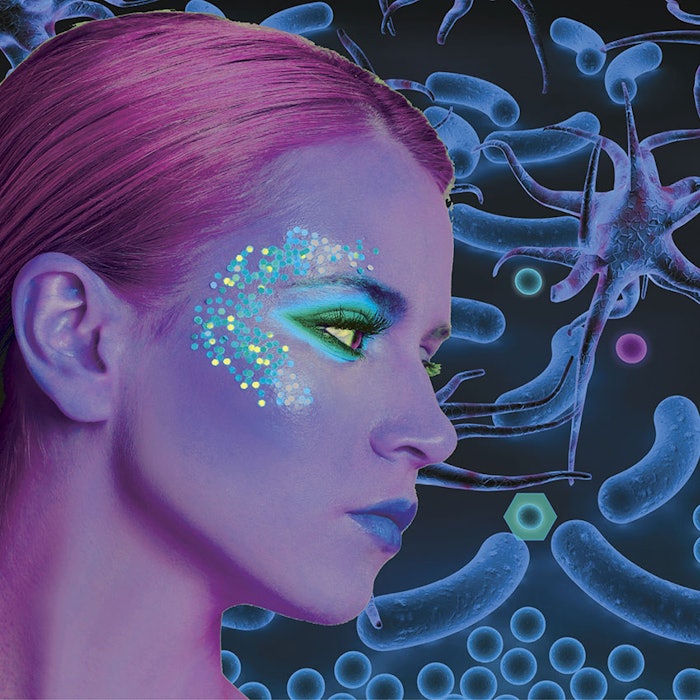
Editor’s note: The cosmetic industry’s knowledge of microbes and their potential applications has grown tremendously. One area of recent interest is the skin microbiome, which can be manipulated for desired effects. Another is the utilization of microbes for the sustainable and economical production of natural materials; such as the upstream production of cosmetic pigments described here. The processes presented here are at the forefront of innovation and their use holds potential for future marketing claims to appeal to environmentally conscious consumers.
Anthocyanins are ubiquitous flavonoid compounds found naturally in plants. With promising health-promoting and skin-protection functions, they hold great potential for cosmetics. The sustainable supply of anthocyanins for industrial purposes has become increasingly important in recent years. As such, their microbial production provides a more sustainable and controllable approach over traditional plant extraction. This has successfully been achieved with the employment of novel metabolic engineering strategies.
This review first focuses on the potential of microbial-produced anthocyanins in color cosmetics and their supply. Part two then looks in detail at strategies to use Escherichia coli. Anthocyanin production by plants is compared with engineering by E. coli, with a major emphasis on metabolic approaches and tactics in biocatalysis and coculturing. Specifically described are approaches to strain development such as enzyme selection, enzyme engineering and the regulation of cofactor supply and anthocyanin efflux. Finally, a new biocatalytic process to enable de novo anthocyanin production from glucose via a polyculture is discussed.
Cosmetic Potential of Anthocyanins
Over the past decade, the global demand for cosmetics has continuously increased, which is expected to continue. This will require the development of more diverse and effective products.1 Plant extracts attract consumer interest due, in part, to an innate fondness for that which is “natural.” However, natural ingredients have long been incorporated in cosmetics due to the specific activities of components in them; such as scavenging free radicals, treating dry skin, improving signs of aging, etc.2, 3
Among these components are flavonoids; specifically anthocyanins, which are based on a wide group of flavylium compounds in plants. They function as pigments, antioxidants and antimicrobials during a plant’s growth (see Figure 1). They also have been widely used as colorants in food and beverage manufacturing.4
As effective antioxidants against reactive oxygen species, anthocyanins can strongly absorb visible and UV light owing to their tricyclic aromatic structure.5 They also can protect skin from aging and UV-induced damage,6 such as inflammation and oxidative damage in the epidermis, dermis and adnexal organs.4 Their fundamental mechanisms have been investigated in several in vitro cellular and animal models, although detailed in vivo studies have yet to be performed.7, 8
Anthocyanins function as pigments, antioxidants and antimicrobials during a plant's growth.
In general, anthocyanins reduce UV-induced elevations of cyclooxygenase-2 and prostaglandin E2 through NFΚβ-dependent pathways. Moreover, anthocyanins decrease apoptotic cell death by inhibiting caspase-3 activation and reducing the proapoptotic Bax protein levels.7, 9
To date, cosmetic products incorporating pure anthocyanins have not yet been approved or marketed. However, trials have been conducted on the development of anthocyanin-colored lipsticks.10 Also, Nutrasorb, LLC, a spin-off of Rutgers, has engineered a red lettuce for use as both a food supplement and a cosmetic additive.11
The inclusion of anthocyanins in cosmetics and skin care products may facilitate the alleviation of sensitivities caused either by direct contact with other chemicals in the formula, or help to rejuvenate skin by reducing wrinkles, dark spots, redness and other skin problems resulting from aging and skin damage.12, 13 It is important to note, though, that anthocyanins currently approved for use are derived from plants. Those produced via microbes would require regulatory approval since they derive from a recombinant microorganism. However, with further investigations into the skin-protective functions of anthocyanins, along with decreasing production costs and regulatory approval, cosmetics containing anthocyanins may find their way into the market in the near future.14
Anthocyanin Supply
Currently, the supply of anthocyanins mostly relies on traditional extraction from plant tissues. However, concerns over seasonal supply and quality control, inherent in agricultural products, necessitate a sustainable and controllable method to produce anthocyanins.15, 16 Chemical synthesis has been investigated to provide regular or 13C labeled anthocyanins, such as peonidin 3-O-glucoside and 13C labelled cyanidin 3-O-glucoside, for clinical trials.17, 18 This method depends upon the Robinson’s acidic aldol condensation between a phenolic aldehyde and an aryl ketone. By tailoring different phenolic aldehydes and aryl ketones, non-natural anthocyanins can be created to provide a valuable reservoir for clinical use. However, chemical synthesis requires environmentally unfriendly and toxic reagents, and long and complicated reactions, leading to poor yields. To date, few studies have explored their chemical synthesis and no apparent anthocyanins created by chemical synthesis are commercially available.18
As such, the microbial production of anthocyanins has been explored using metabolically engineered microorganisms to produce specified anthocyanins in a controlled setting, which fits the requirement for industrial manufacturing. Part II explores these processes.











